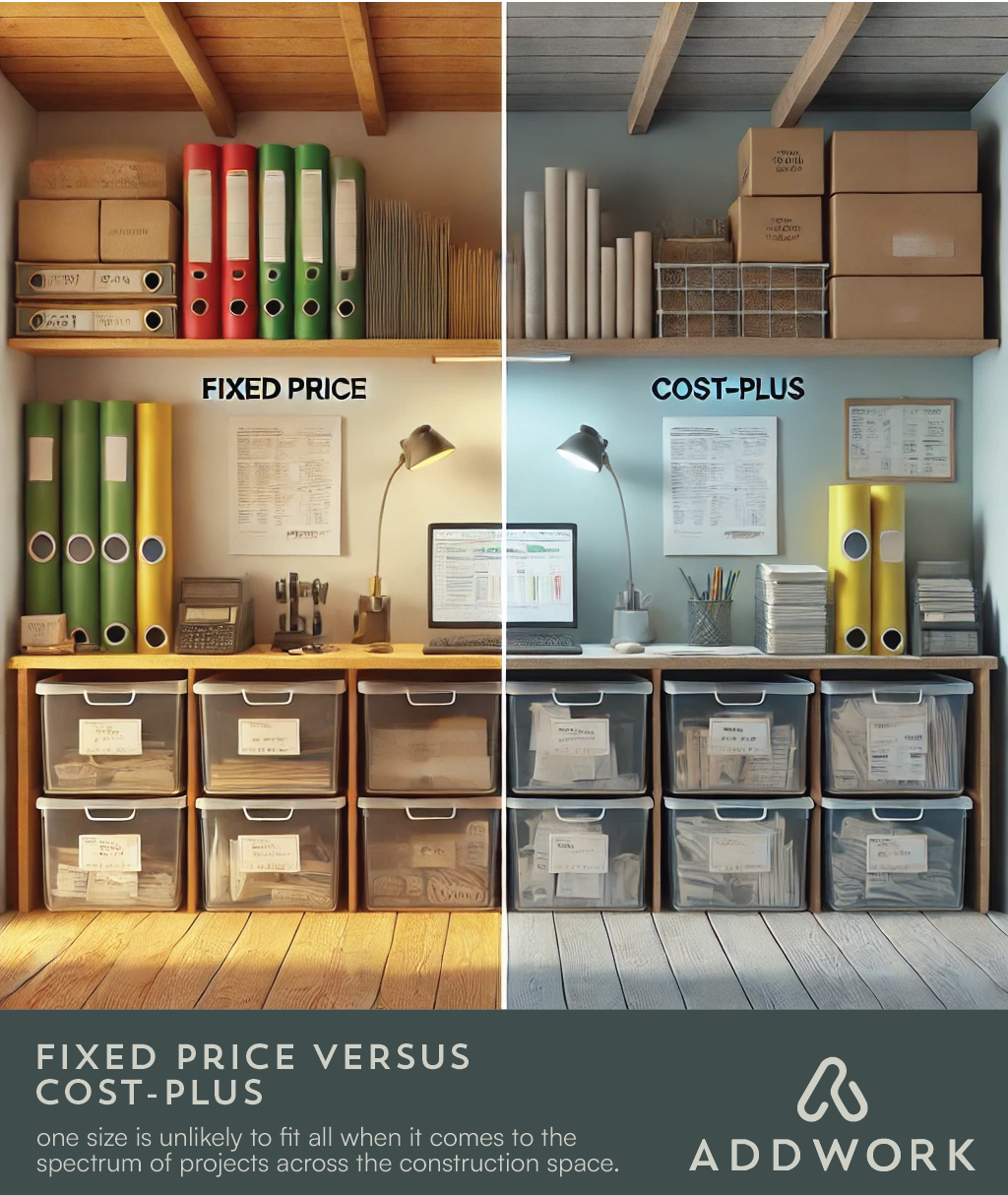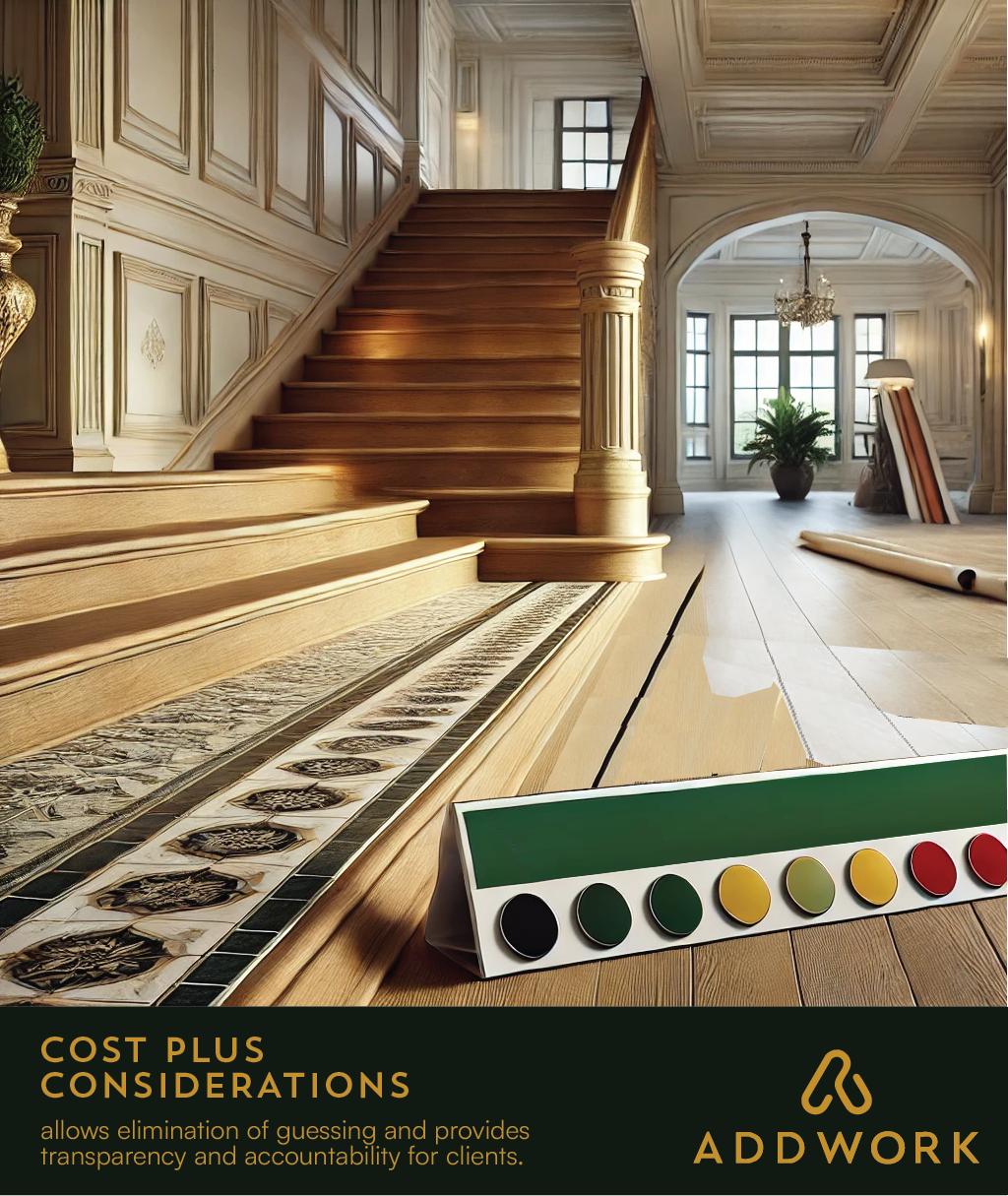
RECENT BLOG
ESTIMATES |
FIXED COST
OR PRICE+
Fixed Price vs. Cost Plus - Which One is Right for You?
When it comes to construction contracts, you’re typically looking at two main types: fixed price contracts and cost plus contracts. Each has its advantages and challenges, and understanding when and how to use them can make a big difference in your profitability and efficiency.
I've had my fair share of experience with both, the good, the bad and several that make me question life’s big questions, what is the meaning of all this? So let’s break it down in a way that helps us decide which might be best for you at different stages of your business.

Understanding the Basics
At its core, a construction contract is an agreement between you and the owner based on a defined scope of work—sometimes tied to a set of plans, sometimes just a general agreement on what needs to be done.
Fixed Price Contracts: Predictability and Profitability
A fixed price contract means exactly what it sounds like: the price is set from the beginning. Let's say you're remodeling a kitchen. Your agreement might include tearing out the old one, installing new cabinetry, flooring, countertops, backsplash, electrical, plumbing, HVAC adjustments, painting, and putting in the appliances. Everything is covered in one total price—let’s say, $76,500.
The biggest advantage of a fixed price contract? Profit control.
- You know exactly what you're charging.
- You can bake in a healthy margin (especially on smaller jobs where competition is lower).
- Owners feel comfortable because they know their final price upfront.
Early in my career, I mostly did fixed price contracts because they can be serious profit centers—especially on smaller projects. As an example, a cost-plus contract on a $50,000 project might limit you to a markup of 20% markup only ($10,000 net). One reason why being that the expectation of uncertainty for the client could reduce their willingness to sign away larger margins. However, a fixed price contract on that same project might bring in $20,000 or more in profit if for no other reason than the home owner can theoretically operate with greater peace of mind.
But for the contractor, with fixed pricing, there’s a catch.
With fixed price work, you need a painstakingly detailed scope of work to avoid losing money on things that weren’t explicitly included. Because trust me—if something is even slightly open to interpretation, the client will interpret it in their favor.
Take crown molding, for example. You didn’t include it in the contract, but the homeowner assumed it was part of the deal. Now you’re in a standoff at the job site, pointing at the contract like a defense attorney while they stare at the empty space above their cabinets, wondering why you’re trying to rob them of their rightful trim. And since fixed price contracts aren’t transparent, you don’t have an easy way to show where the money is going—so guess who’s eating that cost? (Hint: It’s not them.)
As your business grows, fixed price work gets even trickier. When you’re a one-person show, you’ve got all the numbers locked in your brain—what you marked up, which subs gave you a deal, and who owes you a favor for bailing them out last summer. But once you start hiring project managers, estimators, and sales reps, suddenly you’re playing a very dangerous game of telephone. Keeping track of your pricing structure starts feeling less like business strategy and more like advanced memory training.
And then there’s the client factor. As project sizes (and client budgets) increase, so does their financial savviness. Suddenly, they’re asking more questions, demanding itemized breakdowns, and doing math—which, let’s be honest, is never good news for a fixed price contractor. The moment they overhear that your framer is charging $12,000, but you’re charging $30,000, they start looking at you like you just tried to sell them a used car with a "special dealer fee."
Never mind that you're managing the entire project, handling the subs, scheduling deliveries, putting out fires (sometimes literally), and making sure their dream home doesn’t turn into a DIY nightmare. Once they see the numbers, they start thinking, "Wait a minute… I could have hired that framer directly and saved all this money!" (Narrator: They could not.)

Cost Plus Contracts: Transparency and Scalability
A cost plus contract works differently. Instead of setting a fixed price, you’re saying:
“I will complete this project, and whatever it costs me—from the last penny at Home Depot to my admin expenses—I’ll pass those costs through to you with a markup of a certain percent.”
That markup could be 10%, 15%, 20%, even 30-35%, depending on the job size, location, complexities and much more.
The biggest advantage of cost plus? Transparency and scalability that can protect you as a builder to a larger extent.
- Clients see exactly where their money is going.
- There’s no guessing or "padding" costs—it's all documented.
- It's easier to scale your business because you’re not trying to memorize cost structures.
- Winning jobs becomes simpler—clients appreciate the openness and don’t feel like they’re being taken advantage of.

Why I Switched to Cost Plus
As my projects got bigger, clients started demanding more visibility. They wanted to see every invoice, every sub’s charge, every material cost. It just made sense to switch to cost plus.
When bidding a project, I can:
- Hand the plans to my PM or estimator.
- Have them create a detailed scope of work.
- Send it out to subs for pricing.
- Compile the numbers, add my markup, and present the total to the client—no guesswork, no fluff.
It simplifies everything. There’s no debate about where the money is going, no hidden costs, and no awkward moments when a subcontractor "accidentally" spills the real price to the homeowner.
Clients understand what they’re paying for—and even if they don’t love paying a markup, they respect the process.
The Hybrid Approach: Using Fixed Price as a Bonus
Even though I mainly roll with cost plus these days, I still dabble in fixed price jobs—but only when it makes sense. Think of it like adding a side of fries to your meal… except the fries are a delicious pile of predictable, high-margin cash.
For example, let’s say a homeowner comes to me with a “small” foundation repair. (Spoiler: No foundation repair is ever actually small, but let's pretend.) They ask for a quote, and after sizing up the job, I might say:
“This will cost me around $12,000-$15,000 to complete, so I’ll charge you a fixed price of $20,000.”
Boom. Locked in. No surprises. No nickel-and-diming over the cost of rebar or whether epoxy should be an “add-on.” Just clean, upfront pricing that makes both of our lives easier.
Now, imagine doing one of these once a month. That’s an easy extra $100,000 a year in profit—just for saying yes to the right fixed-price jobs. It’s like playing a video game on easy mode: get in, get out, get paid.
So while cost plus is my bread and butter, fixed price is the icing on the cake… the bonus round… the golden goose that occasionally waddles into my inbox asking for a quote. And when the numbers are right, I am more than happy to grab that goose and let it lay a few extra profit eggs.
Moral of the story? Keep your options open. You never know when a quick, clean fixed-price job will show up and give your bottom line a little extra love.
1. If you’re just starting out – Fixed price can be great for maximizing profit, especially on smaller jobs where competition is lower. But be meticulous with your scope of work to avoid disputes.
2. If you’re growing your company – Consider transitioning to cost plus as your projects get larger. It removes a ton of financial guesswork and makes scaling much easier.
3. If you want to maximize earnings – Use a hybrid approach. Keep your main business cost plus but cherry-pick fixed price jobs when they’re low-risk, high-reward.
At the end of the day, both contract types have their place—it’s just about knowing when and how to use them to your advantage.
READY TO
GET STARTED?

